Sustainable Building: Resource Conservation and Cost Efficiency Report
VerifiedAdded on 2023/03/31
|32
|6534
|263
Report
AI Summary
This report presents a comprehensive overview of sustainable building practices within the construction industry, focusing on the implementation of sustainability principles. It examines the triple bottom line approach, which encompasses cost efficiency, resource conservation, and human-adaptive designs. The report delves into various strategies for resource conservation, including energy, material, water, and land conservation, highlighting the importance of waste minimization and the specification of durable and local materials. It explores factors influencing the adoption of sustainable building, such as employee skills, technology, and design considerations, including environmental and social aspects. The report also discusses energy-efficient technologies, passive energy designs, and the significance of designing for human adaptation. Through an analysis of these elements, the paper aims to promote sustainable building practices, reduce environmental impact, and create a more sustainable future for the construction industry. The report concludes with key findings and recommendations, emphasizing the importance of integrating sustainability into all aspects of building projects.
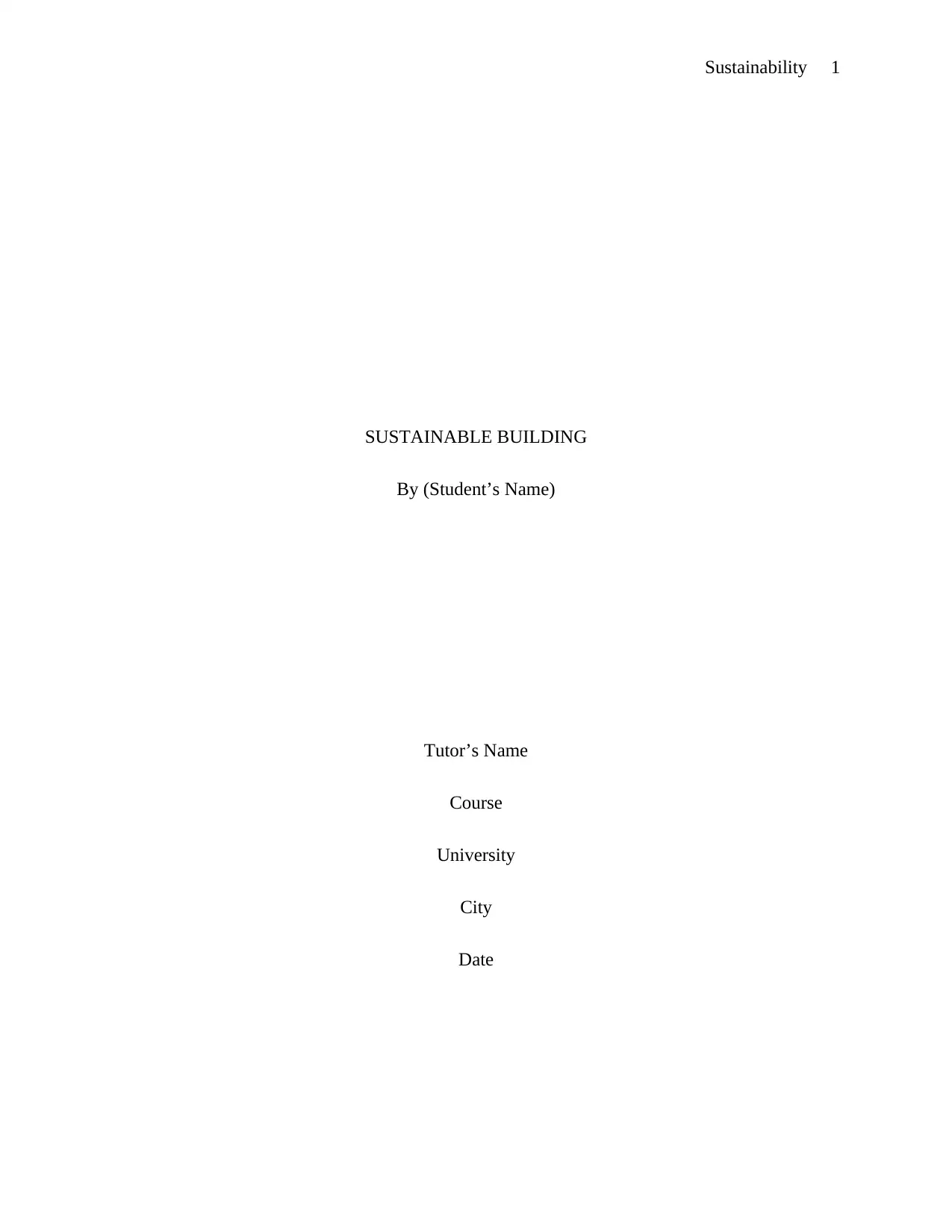
Sustainability 1
SUSTAINABLE BUILDING
By (Student’s Name)
Tutor’s Name
Course
University
City
Date
SUSTAINABLE BUILDING
By (Student’s Name)
Tutor’s Name
Course
University
City
Date
Paraphrase This Document
Need a fresh take? Get an instant paraphrase of this document with our AI Paraphraser
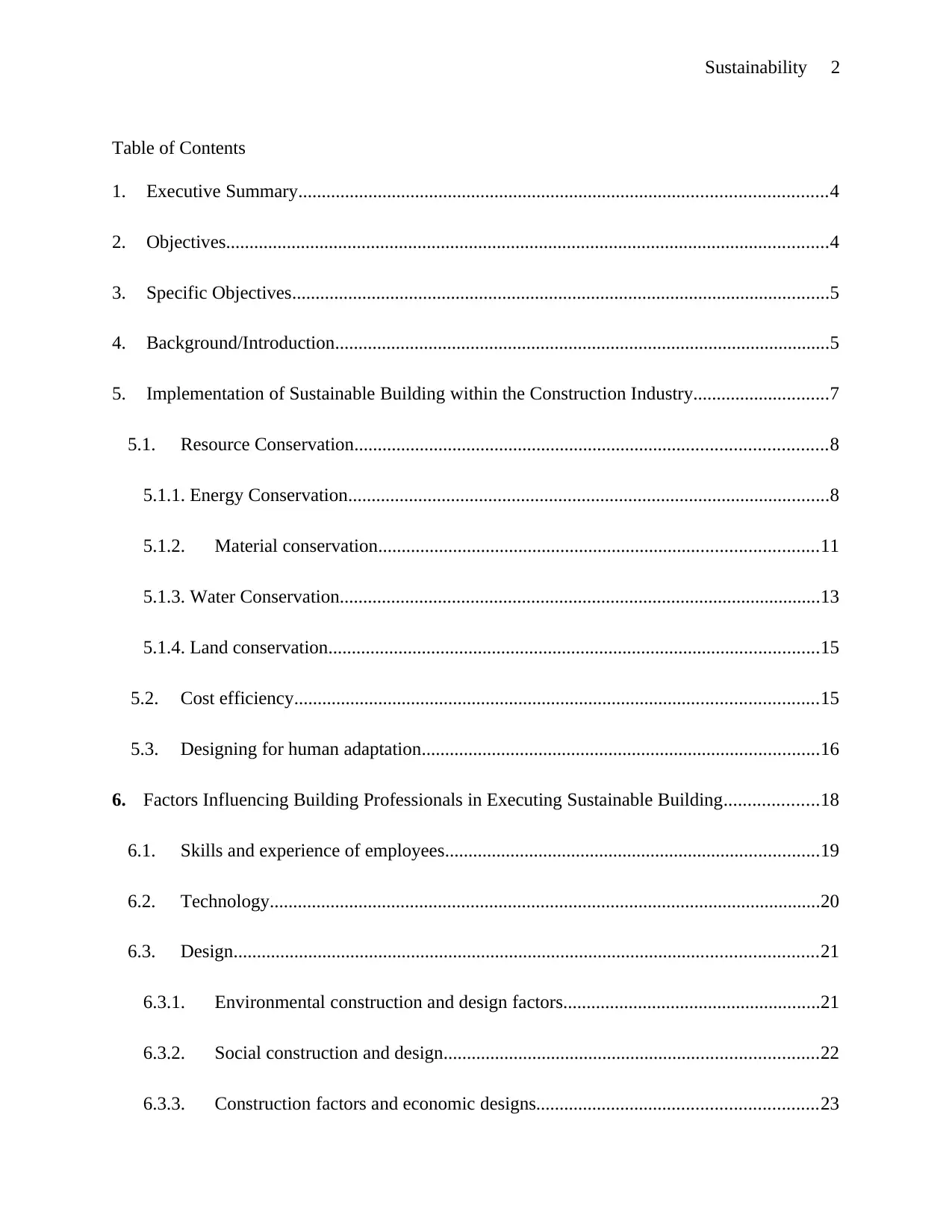
Sustainability 2
Table of Contents
1. Executive Summary.................................................................................................................4
2. Objectives.................................................................................................................................4
3. Specific Objectives...................................................................................................................5
4. Background/Introduction..........................................................................................................5
5. Implementation of Sustainable Building within the Construction Industry.............................7
5.1. Resource Conservation.....................................................................................................8
5.1.1. Energy Conservation.......................................................................................................8
5.1.2. Material conservation..............................................................................................11
5.1.3. Water Conservation.......................................................................................................13
5.1.4. Land conservation.........................................................................................................15
5.2. Cost efficiency................................................................................................................15
5.3. Designing for human adaptation.....................................................................................16
6. Factors Influencing Building Professionals in Executing Sustainable Building....................18
6.1. Skills and experience of employees................................................................................19
6.2. Technology......................................................................................................................20
6.3. Design.............................................................................................................................21
6.3.1. Environmental construction and design factors.......................................................21
6.3.2. Social construction and design................................................................................22
6.3.3. Construction factors and economic designs............................................................23
Table of Contents
1. Executive Summary.................................................................................................................4
2. Objectives.................................................................................................................................4
3. Specific Objectives...................................................................................................................5
4. Background/Introduction..........................................................................................................5
5. Implementation of Sustainable Building within the Construction Industry.............................7
5.1. Resource Conservation.....................................................................................................8
5.1.1. Energy Conservation.......................................................................................................8
5.1.2. Material conservation..............................................................................................11
5.1.3. Water Conservation.......................................................................................................13
5.1.4. Land conservation.........................................................................................................15
5.2. Cost efficiency................................................................................................................15
5.3. Designing for human adaptation.....................................................................................16
6. Factors Influencing Building Professionals in Executing Sustainable Building....................18
6.1. Skills and experience of employees................................................................................19
6.2. Technology......................................................................................................................20
6.3. Design.............................................................................................................................21
6.3.1. Environmental construction and design factors.......................................................21
6.3.2. Social construction and design................................................................................22
6.3.3. Construction factors and economic designs............................................................23
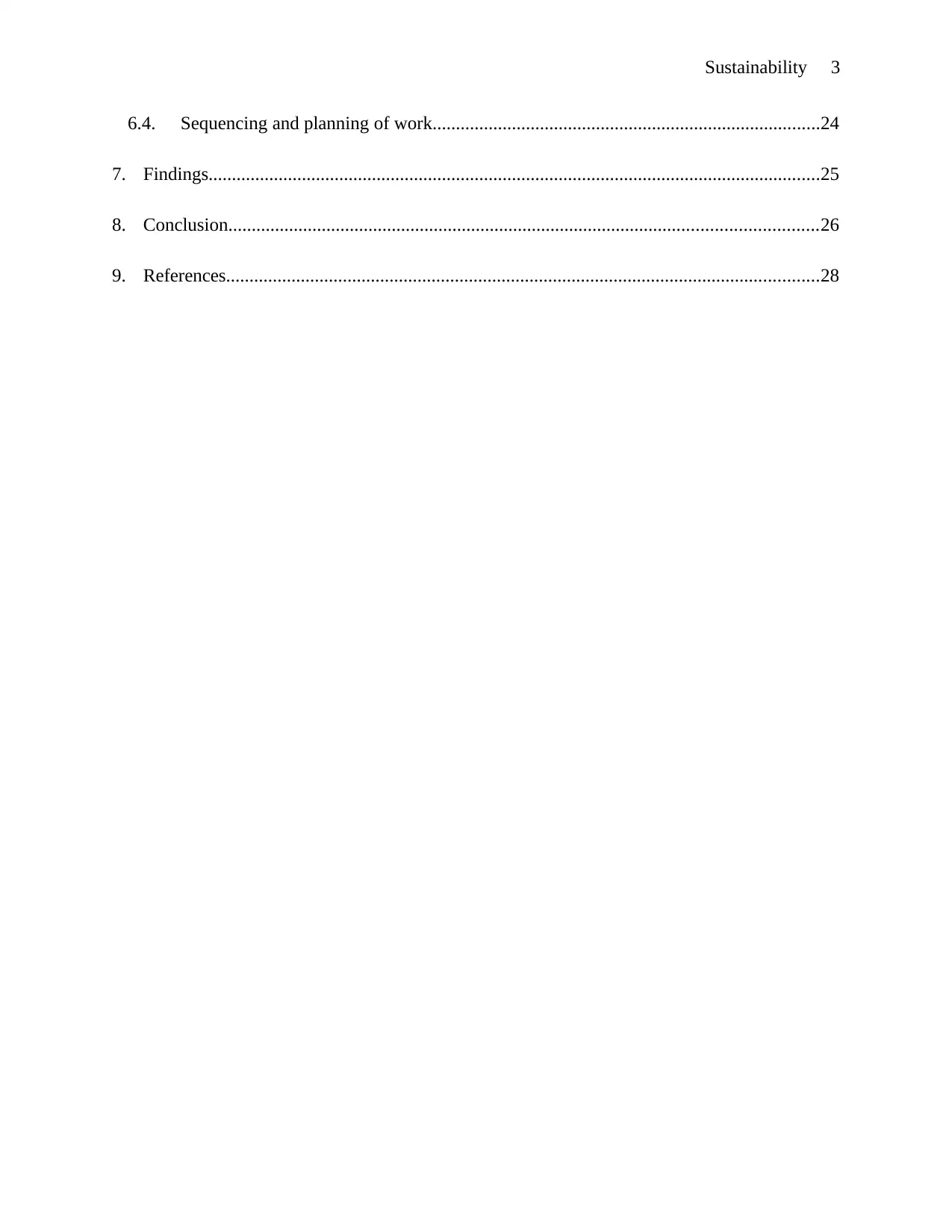
Sustainability 3
6.4. Sequencing and planning of work...................................................................................24
7. Findings...................................................................................................................................25
8. Conclusion..............................................................................................................................26
9. References...............................................................................................................................28
6.4. Sequencing and planning of work...................................................................................24
7. Findings...................................................................................................................................25
8. Conclusion..............................................................................................................................26
9. References...............................................................................................................................28
⊘ This is a preview!⊘
Do you want full access?
Subscribe today to unlock all pages.

Trusted by 1+ million students worldwide
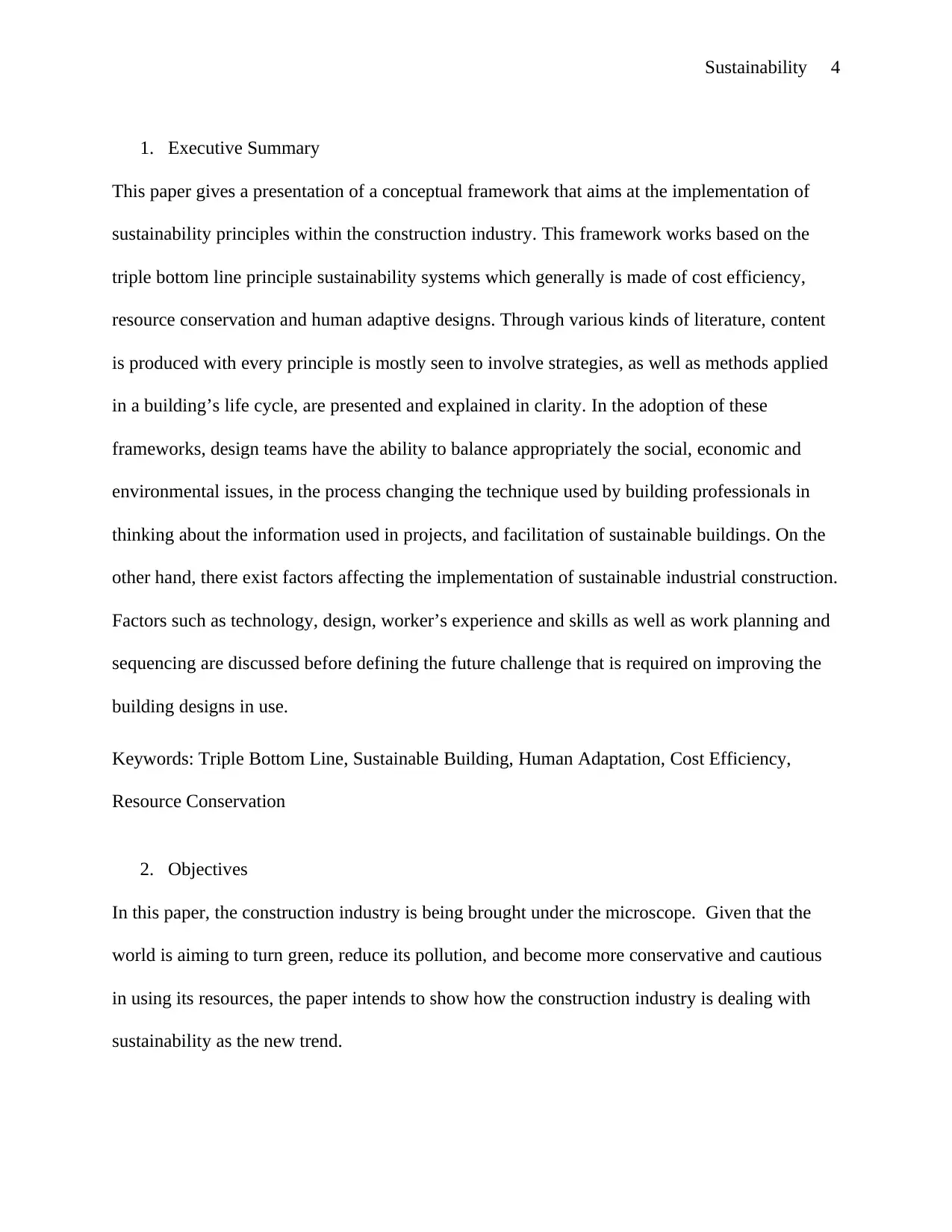
Sustainability 4
1. Executive Summary
This paper gives a presentation of a conceptual framework that aims at the implementation of
sustainability principles within the construction industry. This framework works based on the
triple bottom line principle sustainability systems which generally is made of cost efficiency,
resource conservation and human adaptive designs. Through various kinds of literature, content
is produced with every principle is mostly seen to involve strategies, as well as methods applied
in a building’s life cycle, are presented and explained in clarity. In the adoption of these
frameworks, design teams have the ability to balance appropriately the social, economic and
environmental issues, in the process changing the technique used by building professionals in
thinking about the information used in projects, and facilitation of sustainable buildings. On the
other hand, there exist factors affecting the implementation of sustainable industrial construction.
Factors such as technology, design, worker’s experience and skills as well as work planning and
sequencing are discussed before defining the future challenge that is required on improving the
building designs in use.
Keywords: Triple Bottom Line, Sustainable Building, Human Adaptation, Cost Efficiency,
Resource Conservation
2. Objectives
In this paper, the construction industry is being brought under the microscope. Given that the
world is aiming to turn green, reduce its pollution, and become more conservative and cautious
in using its resources, the paper intends to show how the construction industry is dealing with
sustainability as the new trend.
1. Executive Summary
This paper gives a presentation of a conceptual framework that aims at the implementation of
sustainability principles within the construction industry. This framework works based on the
triple bottom line principle sustainability systems which generally is made of cost efficiency,
resource conservation and human adaptive designs. Through various kinds of literature, content
is produced with every principle is mostly seen to involve strategies, as well as methods applied
in a building’s life cycle, are presented and explained in clarity. In the adoption of these
frameworks, design teams have the ability to balance appropriately the social, economic and
environmental issues, in the process changing the technique used by building professionals in
thinking about the information used in projects, and facilitation of sustainable buildings. On the
other hand, there exist factors affecting the implementation of sustainable industrial construction.
Factors such as technology, design, worker’s experience and skills as well as work planning and
sequencing are discussed before defining the future challenge that is required on improving the
building designs in use.
Keywords: Triple Bottom Line, Sustainable Building, Human Adaptation, Cost Efficiency,
Resource Conservation
2. Objectives
In this paper, the construction industry is being brought under the microscope. Given that the
world is aiming to turn green, reduce its pollution, and become more conservative and cautious
in using its resources, the paper intends to show how the construction industry is dealing with
sustainability as the new trend.
Paraphrase This Document
Need a fresh take? Get an instant paraphrase of this document with our AI Paraphraser
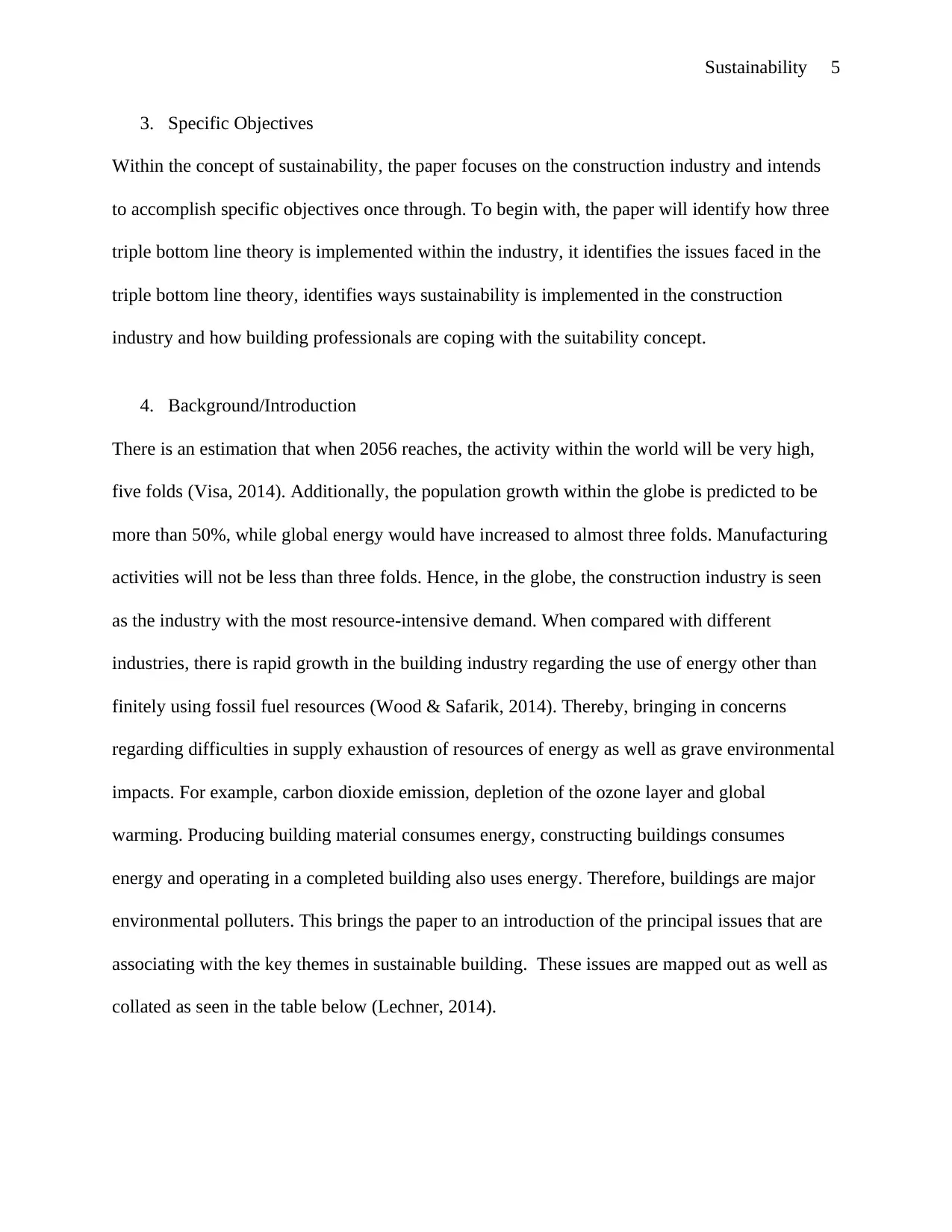
Sustainability 5
3. Specific Objectives
Within the concept of sustainability, the paper focuses on the construction industry and intends
to accomplish specific objectives once through. To begin with, the paper will identify how three
triple bottom line theory is implemented within the industry, it identifies the issues faced in the
triple bottom line theory, identifies ways sustainability is implemented in the construction
industry and how building professionals are coping with the suitability concept.
4. Background/Introduction
There is an estimation that when 2056 reaches, the activity within the world will be very high,
five folds (Visa, 2014). Additionally, the population growth within the globe is predicted to be
more than 50%, while global energy would have increased to almost three folds. Manufacturing
activities will not be less than three folds. Hence, in the globe, the construction industry is seen
as the industry with the most resource-intensive demand. When compared with different
industries, there is rapid growth in the building industry regarding the use of energy other than
finitely using fossil fuel resources (Wood & Safarik, 2014). Thereby, bringing in concerns
regarding difficulties in supply exhaustion of resources of energy as well as grave environmental
impacts. For example, carbon dioxide emission, depletion of the ozone layer and global
warming. Producing building material consumes energy, constructing buildings consumes
energy and operating in a completed building also uses energy. Therefore, buildings are major
environmental polluters. This brings the paper to an introduction of the principal issues that are
associating with the key themes in sustainable building. These issues are mapped out as well as
collated as seen in the table below (Lechner, 2014).
3. Specific Objectives
Within the concept of sustainability, the paper focuses on the construction industry and intends
to accomplish specific objectives once through. To begin with, the paper will identify how three
triple bottom line theory is implemented within the industry, it identifies the issues faced in the
triple bottom line theory, identifies ways sustainability is implemented in the construction
industry and how building professionals are coping with the suitability concept.
4. Background/Introduction
There is an estimation that when 2056 reaches, the activity within the world will be very high,
five folds (Visa, 2014). Additionally, the population growth within the globe is predicted to be
more than 50%, while global energy would have increased to almost three folds. Manufacturing
activities will not be less than three folds. Hence, in the globe, the construction industry is seen
as the industry with the most resource-intensive demand. When compared with different
industries, there is rapid growth in the building industry regarding the use of energy other than
finitely using fossil fuel resources (Wood & Safarik, 2014). Thereby, bringing in concerns
regarding difficulties in supply exhaustion of resources of energy as well as grave environmental
impacts. For example, carbon dioxide emission, depletion of the ozone layer and global
warming. Producing building material consumes energy, constructing buildings consumes
energy and operating in a completed building also uses energy. Therefore, buildings are major
environmental polluters. This brings the paper to an introduction of the principal issues that are
associating with the key themes in sustainable building. These issues are mapped out as well as
collated as seen in the table below (Lechner, 2014).
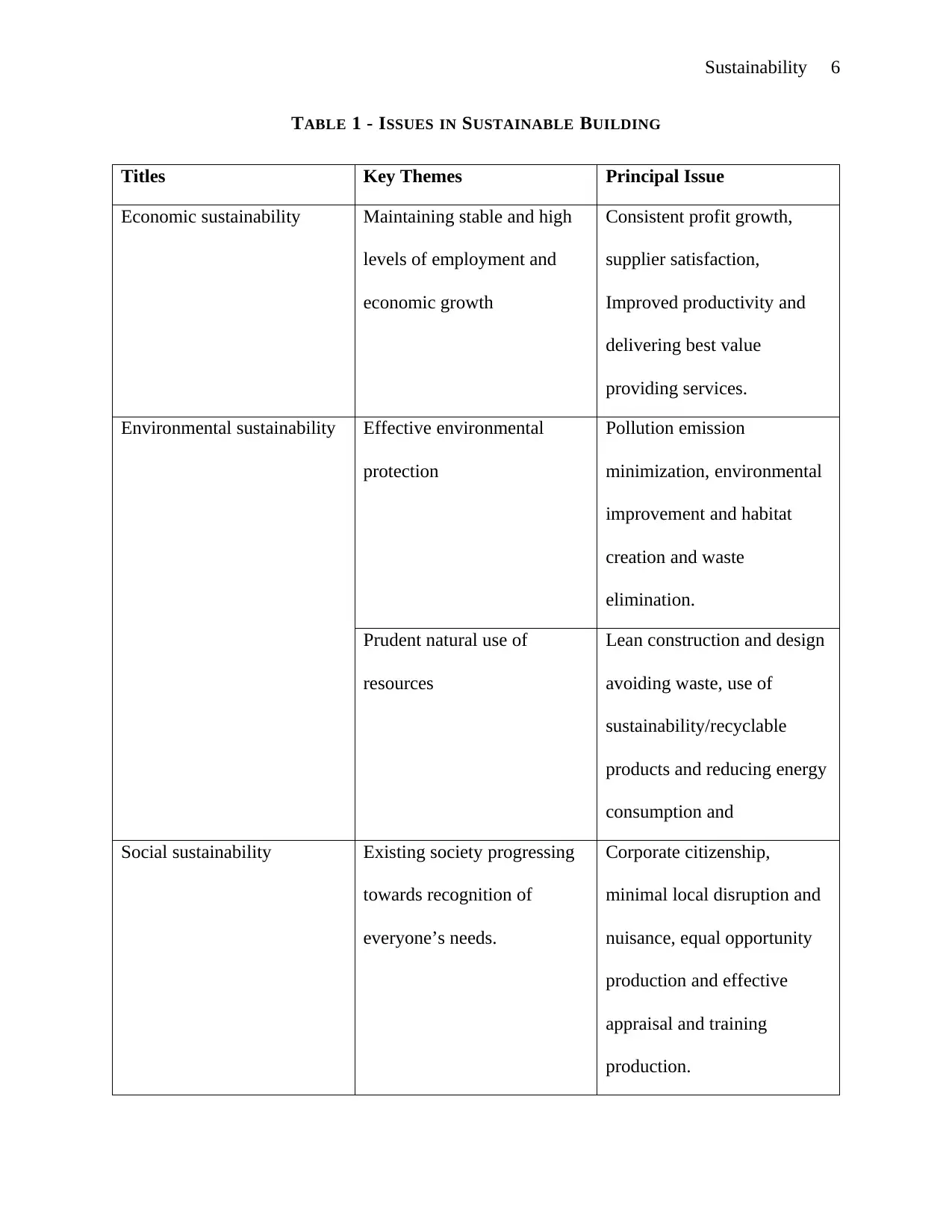
Sustainability 6
TABLE 1 - ISSUES IN SUSTAINABLE BUILDING
Titles Key Themes Principal Issue
Economic sustainability Maintaining stable and high
levels of employment and
economic growth
Consistent profit growth,
supplier satisfaction,
Improved productivity and
delivering best value
providing services.
Environmental sustainability Effective environmental
protection
Pollution emission
minimization, environmental
improvement and habitat
creation and waste
elimination.
Prudent natural use of
resources
Lean construction and design
avoiding waste, use of
sustainability/recyclable
products and reducing energy
consumption and
Social sustainability Existing society progressing
towards recognition of
everyone’s needs.
Corporate citizenship,
minimal local disruption and
nuisance, equal opportunity
production and effective
appraisal and training
production.
TABLE 1 - ISSUES IN SUSTAINABLE BUILDING
Titles Key Themes Principal Issue
Economic sustainability Maintaining stable and high
levels of employment and
economic growth
Consistent profit growth,
supplier satisfaction,
Improved productivity and
delivering best value
providing services.
Environmental sustainability Effective environmental
protection
Pollution emission
minimization, environmental
improvement and habitat
creation and waste
elimination.
Prudent natural use of
resources
Lean construction and design
avoiding waste, use of
sustainability/recyclable
products and reducing energy
consumption and
Social sustainability Existing society progressing
towards recognition of
everyone’s needs.
Corporate citizenship,
minimal local disruption and
nuisance, equal opportunity
production and effective
appraisal and training
production.
⊘ This is a preview!⊘
Do you want full access?
Subscribe today to unlock all pages.

Trusted by 1+ million students worldwide
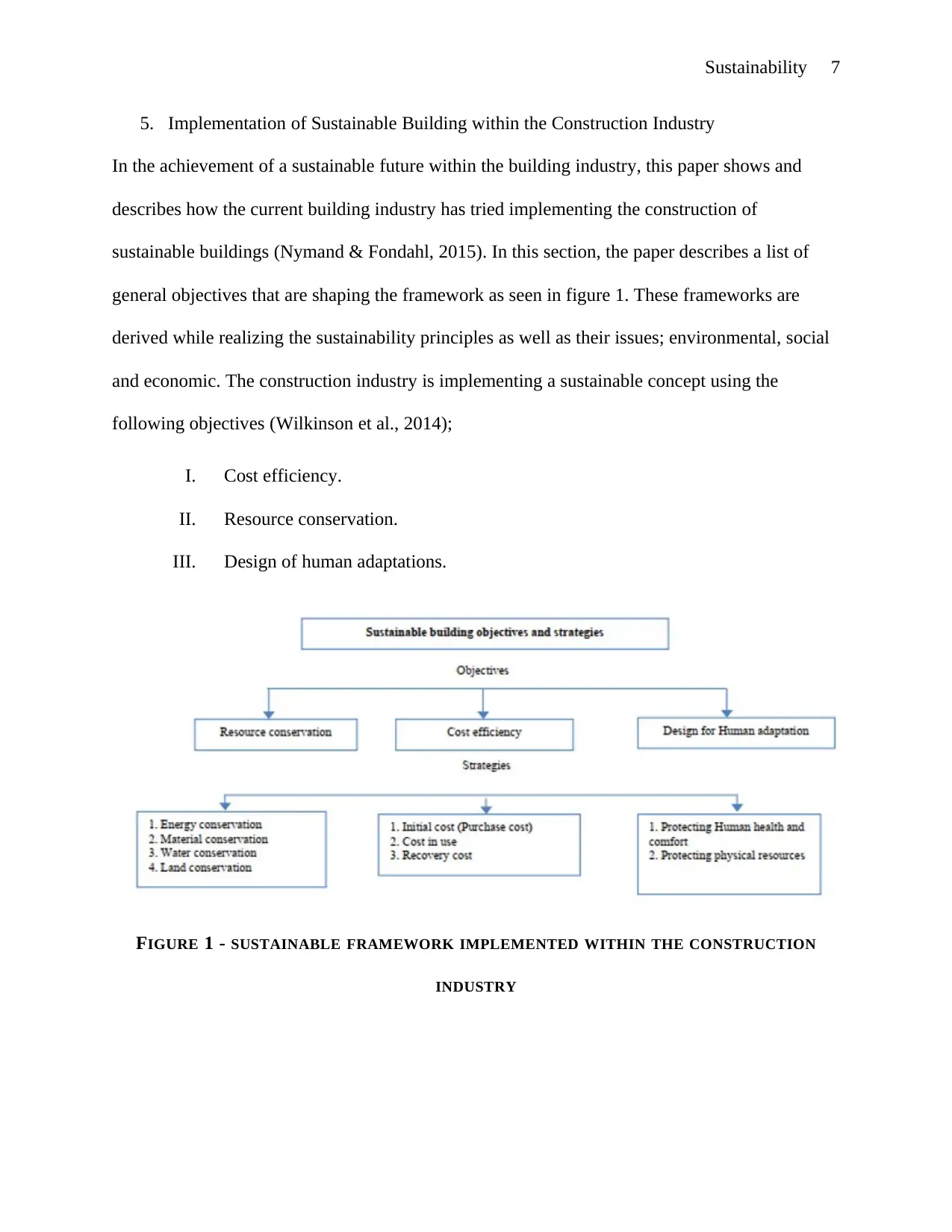
Sustainability 7
5. Implementation of Sustainable Building within the Construction Industry
In the achievement of a sustainable future within the building industry, this paper shows and
describes how the current building industry has tried implementing the construction of
sustainable buildings (Nymand & Fondahl, 2015). In this section, the paper describes a list of
general objectives that are shaping the framework as seen in figure 1. These frameworks are
derived while realizing the sustainability principles as well as their issues; environmental, social
and economic. The construction industry is implementing a sustainable concept using the
following objectives (Wilkinson et al., 2014);
I. Cost efficiency.
II. Resource conservation.
III. Design of human adaptations.
FIGURE 1 - SUSTAINABLE FRAMEWORK IMPLEMENTED WITHIN THE CONSTRUCTION
INDUSTRY
5. Implementation of Sustainable Building within the Construction Industry
In the achievement of a sustainable future within the building industry, this paper shows and
describes how the current building industry has tried implementing the construction of
sustainable buildings (Nymand & Fondahl, 2015). In this section, the paper describes a list of
general objectives that are shaping the framework as seen in figure 1. These frameworks are
derived while realizing the sustainability principles as well as their issues; environmental, social
and economic. The construction industry is implementing a sustainable concept using the
following objectives (Wilkinson et al., 2014);
I. Cost efficiency.
II. Resource conservation.
III. Design of human adaptations.
FIGURE 1 - SUSTAINABLE FRAMEWORK IMPLEMENTED WITHIN THE CONSTRUCTION
INDUSTRY
Paraphrase This Document
Need a fresh take? Get an instant paraphrase of this document with our AI Paraphraser
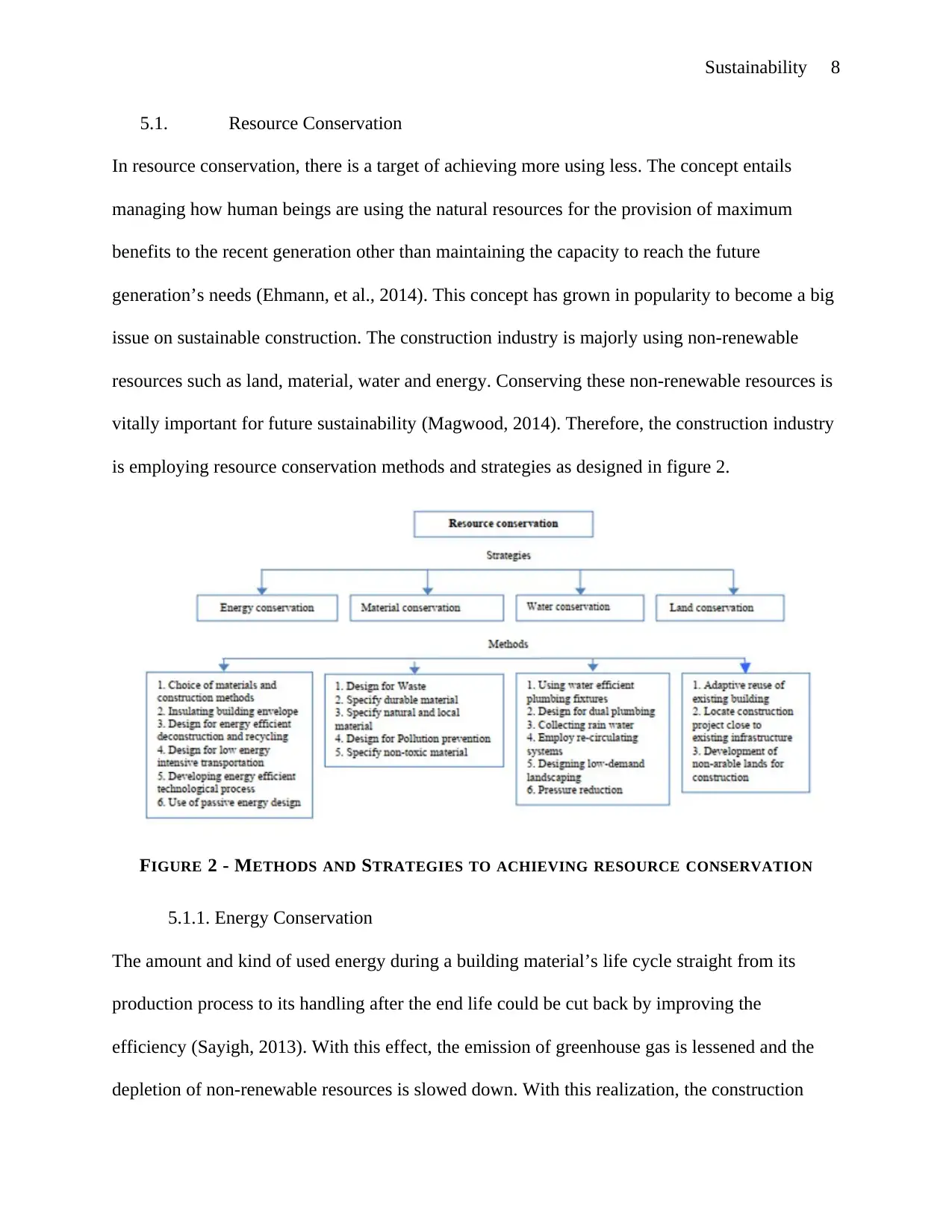
Sustainability 8
5.1. Resource Conservation
In resource conservation, there is a target of achieving more using less. The concept entails
managing how human beings are using the natural resources for the provision of maximum
benefits to the recent generation other than maintaining the capacity to reach the future
generation’s needs (Ehmann, et al., 2014). This concept has grown in popularity to become a big
issue on sustainable construction. The construction industry is majorly using non-renewable
resources such as land, material, water and energy. Conserving these non-renewable resources is
vitally important for future sustainability (Magwood, 2014). Therefore, the construction industry
is employing resource conservation methods and strategies as designed in figure 2.
FIGURE 2 - METHODS AND STRATEGIES TO ACHIEVING RESOURCE CONSERVATION
5.1.1. Energy Conservation
The amount and kind of used energy during a building material’s life cycle straight from its
production process to its handling after the end life could be cut back by improving the
efficiency (Sayigh, 2013). With this effect, the emission of greenhouse gas is lessened and the
depletion of non-renewable resources is slowed down. With this realization, the construction
5.1. Resource Conservation
In resource conservation, there is a target of achieving more using less. The concept entails
managing how human beings are using the natural resources for the provision of maximum
benefits to the recent generation other than maintaining the capacity to reach the future
generation’s needs (Ehmann, et al., 2014). This concept has grown in popularity to become a big
issue on sustainable construction. The construction industry is majorly using non-renewable
resources such as land, material, water and energy. Conserving these non-renewable resources is
vitally important for future sustainability (Magwood, 2014). Therefore, the construction industry
is employing resource conservation methods and strategies as designed in figure 2.
FIGURE 2 - METHODS AND STRATEGIES TO ACHIEVING RESOURCE CONSERVATION
5.1.1. Energy Conservation
The amount and kind of used energy during a building material’s life cycle straight from its
production process to its handling after the end life could be cut back by improving the
efficiency (Sayigh, 2013). With this effect, the emission of greenhouse gas is lessened and the
depletion of non-renewable resources is slowed down. With this realization, the construction
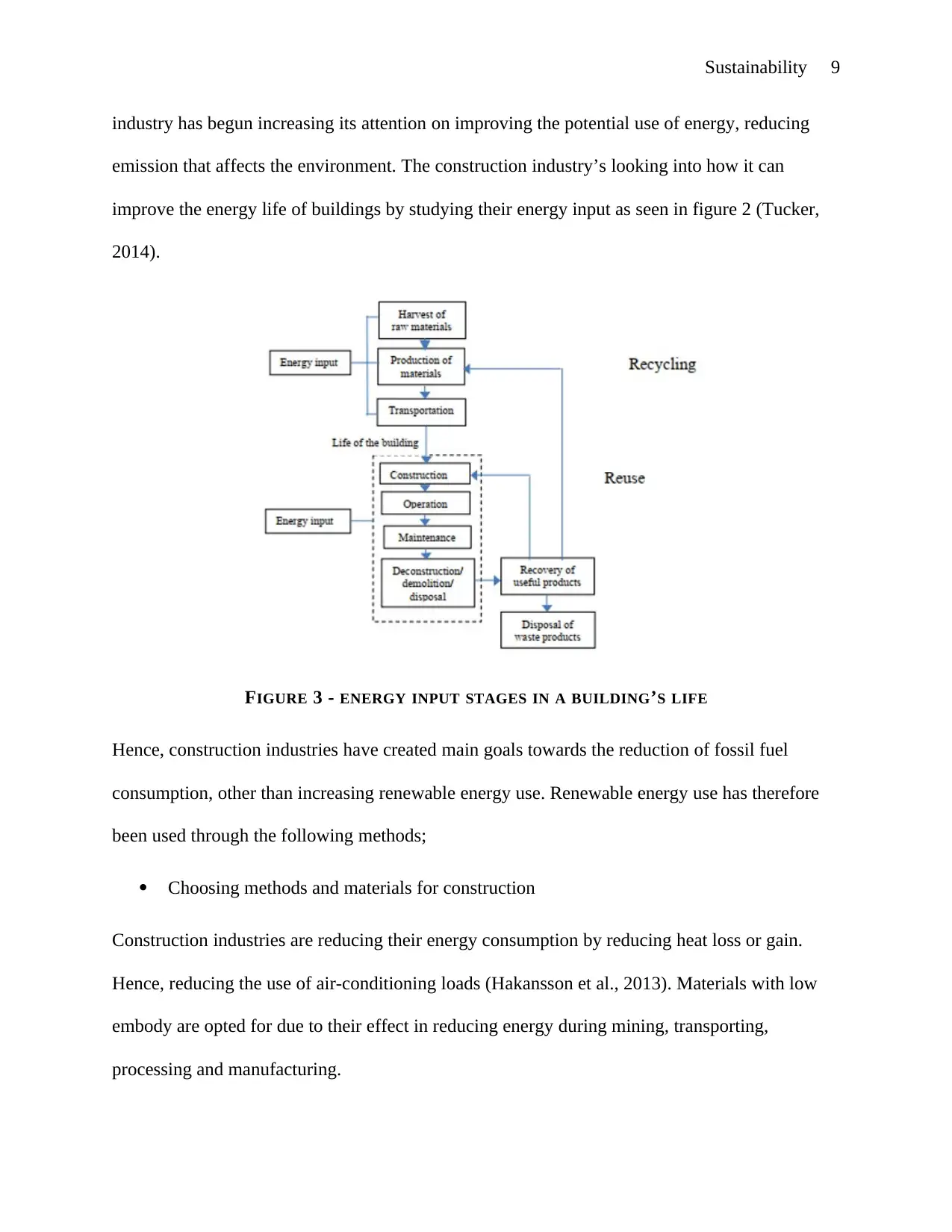
Sustainability 9
industry has begun increasing its attention on improving the potential use of energy, reducing
emission that affects the environment. The construction industry’s looking into how it can
improve the energy life of buildings by studying their energy input as seen in figure 2 (Tucker,
2014).
FIGURE 3 - ENERGY INPUT STAGES IN A BUILDING’S LIFE
Hence, construction industries have created main goals towards the reduction of fossil fuel
consumption, other than increasing renewable energy use. Renewable energy use has therefore
been used through the following methods;
Choosing methods and materials for construction
Construction industries are reducing their energy consumption by reducing heat loss or gain.
Hence, reducing the use of air-conditioning loads (Hakansson et al., 2013). Materials with low
embody are opted for due to their effect in reducing energy during mining, transporting,
processing and manufacturing.
industry has begun increasing its attention on improving the potential use of energy, reducing
emission that affects the environment. The construction industry’s looking into how it can
improve the energy life of buildings by studying their energy input as seen in figure 2 (Tucker,
2014).
FIGURE 3 - ENERGY INPUT STAGES IN A BUILDING’S LIFE
Hence, construction industries have created main goals towards the reduction of fossil fuel
consumption, other than increasing renewable energy use. Renewable energy use has therefore
been used through the following methods;
Choosing methods and materials for construction
Construction industries are reducing their energy consumption by reducing heat loss or gain.
Hence, reducing the use of air-conditioning loads (Hakansson et al., 2013). Materials with low
embody are opted for due to their effect in reducing energy during mining, transporting,
processing and manufacturing.
⊘ This is a preview!⊘
Do you want full access?
Subscribe today to unlock all pages.

Trusted by 1+ million students worldwide
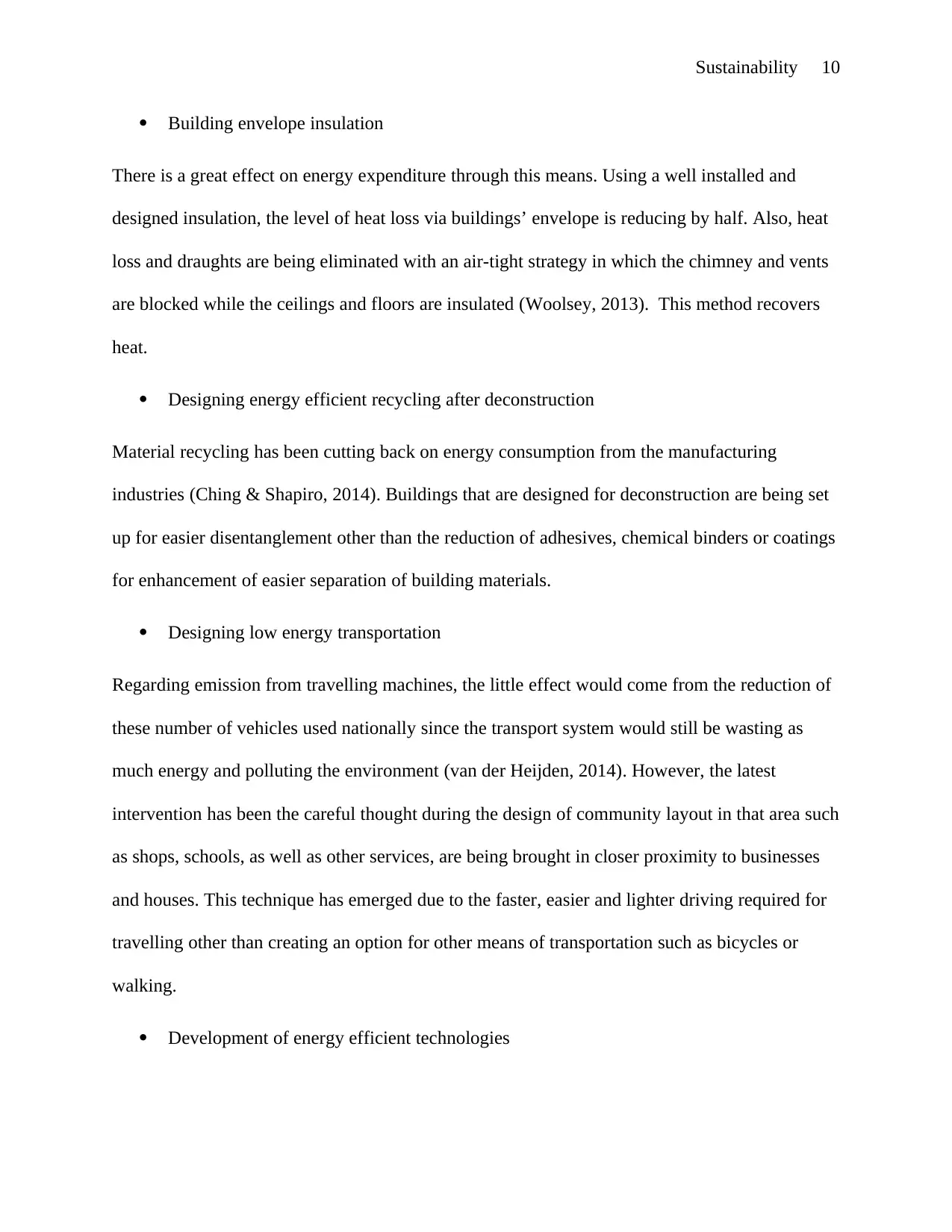
Sustainability 10
Building envelope insulation
There is a great effect on energy expenditure through this means. Using a well installed and
designed insulation, the level of heat loss via buildings’ envelope is reducing by half. Also, heat
loss and draughts are being eliminated with an air-tight strategy in which the chimney and vents
are blocked while the ceilings and floors are insulated (Woolsey, 2013). This method recovers
heat.
Designing energy efficient recycling after deconstruction
Material recycling has been cutting back on energy consumption from the manufacturing
industries (Ching & Shapiro, 2014). Buildings that are designed for deconstruction are being set
up for easier disentanglement other than the reduction of adhesives, chemical binders or coatings
for enhancement of easier separation of building materials.
Designing low energy transportation
Regarding emission from travelling machines, the little effect would come from the reduction of
these number of vehicles used nationally since the transport system would still be wasting as
much energy and polluting the environment (van der Heijden, 2014). However, the latest
intervention has been the careful thought during the design of community layout in that area such
as shops, schools, as well as other services, are being brought in closer proximity to businesses
and houses. This technique has emerged due to the faster, easier and lighter driving required for
travelling other than creating an option for other means of transportation such as bicycles or
walking.
Development of energy efficient technologies
Building envelope insulation
There is a great effect on energy expenditure through this means. Using a well installed and
designed insulation, the level of heat loss via buildings’ envelope is reducing by half. Also, heat
loss and draughts are being eliminated with an air-tight strategy in which the chimney and vents
are blocked while the ceilings and floors are insulated (Woolsey, 2013). This method recovers
heat.
Designing energy efficient recycling after deconstruction
Material recycling has been cutting back on energy consumption from the manufacturing
industries (Ching & Shapiro, 2014). Buildings that are designed for deconstruction are being set
up for easier disentanglement other than the reduction of adhesives, chemical binders or coatings
for enhancement of easier separation of building materials.
Designing low energy transportation
Regarding emission from travelling machines, the little effect would come from the reduction of
these number of vehicles used nationally since the transport system would still be wasting as
much energy and polluting the environment (van der Heijden, 2014). However, the latest
intervention has been the careful thought during the design of community layout in that area such
as shops, schools, as well as other services, are being brought in closer proximity to businesses
and houses. This technique has emerged due to the faster, easier and lighter driving required for
travelling other than creating an option for other means of transportation such as bicycles or
walking.
Development of energy efficient technologies
Paraphrase This Document
Need a fresh take? Get an instant paraphrase of this document with our AI Paraphraser
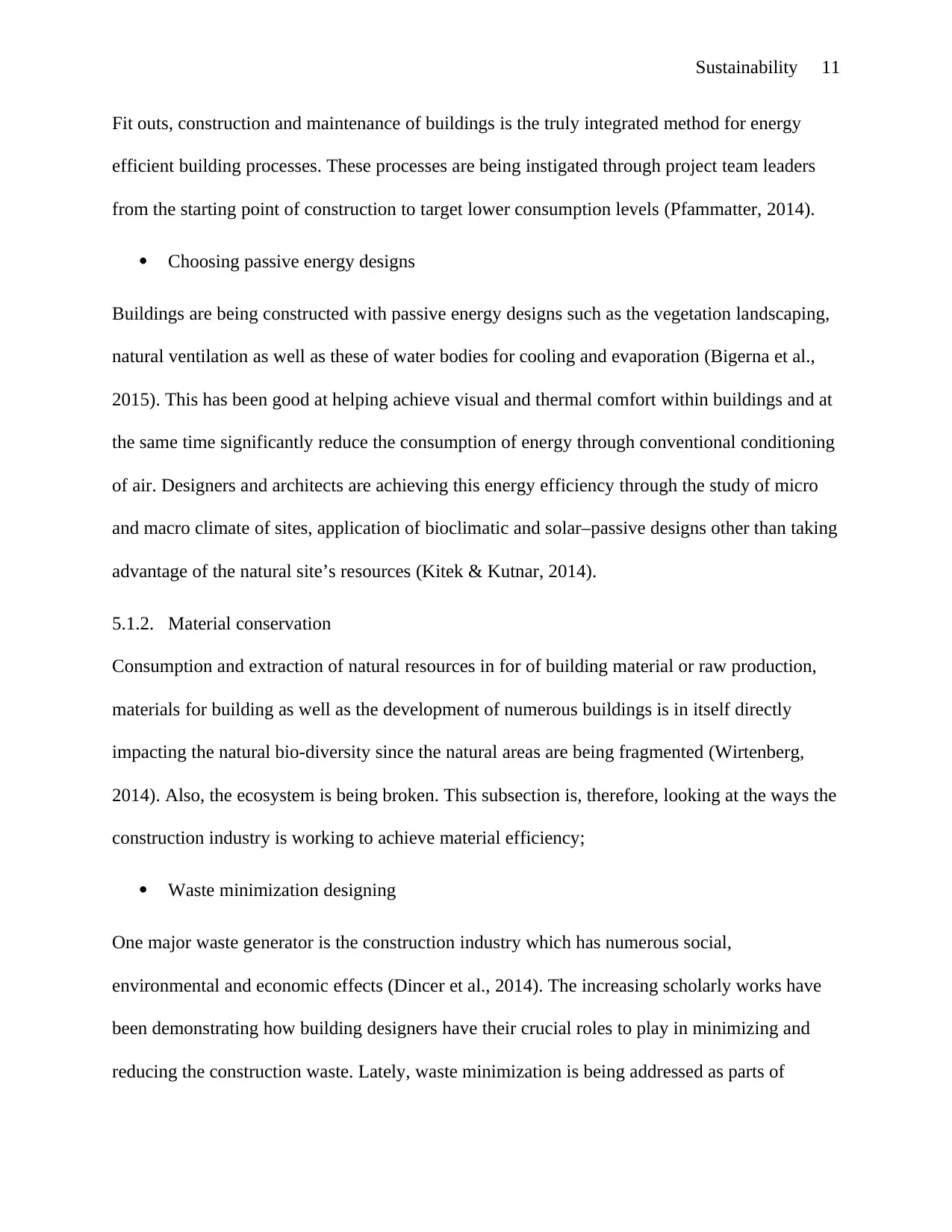
Sustainability 11
Fit outs, construction and maintenance of buildings is the truly integrated method for energy
efficient building processes. These processes are being instigated through project team leaders
from the starting point of construction to target lower consumption levels (Pfammatter, 2014).
Choosing passive energy designs
Buildings are being constructed with passive energy designs such as the vegetation landscaping,
natural ventilation as well as these of water bodies for cooling and evaporation (Bigerna et al.,
2015). This has been good at helping achieve visual and thermal comfort within buildings and at
the same time significantly reduce the consumption of energy through conventional conditioning
of air. Designers and architects are achieving this energy efficiency through the study of micro
and macro climate of sites, application of bioclimatic and solar–passive designs other than taking
advantage of the natural site’s resources (Kitek & Kutnar, 2014).
5.1.2. Material conservation
Consumption and extraction of natural resources in for of building material or raw production,
materials for building as well as the development of numerous buildings is in itself directly
impacting the natural bio-diversity since the natural areas are being fragmented (Wirtenberg,
2014). Also, the ecosystem is being broken. This subsection is, therefore, looking at the ways the
construction industry is working to achieve material efficiency;
Waste minimization designing
One major waste generator is the construction industry which has numerous social,
environmental and economic effects (Dincer et al., 2014). The increasing scholarly works have
been demonstrating how building designers have their crucial roles to play in minimizing and
reducing the construction waste. Lately, waste minimization is being addressed as parts of
Fit outs, construction and maintenance of buildings is the truly integrated method for energy
efficient building processes. These processes are being instigated through project team leaders
from the starting point of construction to target lower consumption levels (Pfammatter, 2014).
Choosing passive energy designs
Buildings are being constructed with passive energy designs such as the vegetation landscaping,
natural ventilation as well as these of water bodies for cooling and evaporation (Bigerna et al.,
2015). This has been good at helping achieve visual and thermal comfort within buildings and at
the same time significantly reduce the consumption of energy through conventional conditioning
of air. Designers and architects are achieving this energy efficiency through the study of micro
and macro climate of sites, application of bioclimatic and solar–passive designs other than taking
advantage of the natural site’s resources (Kitek & Kutnar, 2014).
5.1.2. Material conservation
Consumption and extraction of natural resources in for of building material or raw production,
materials for building as well as the development of numerous buildings is in itself directly
impacting the natural bio-diversity since the natural areas are being fragmented (Wirtenberg,
2014). Also, the ecosystem is being broken. This subsection is, therefore, looking at the ways the
construction industry is working to achieve material efficiency;
Waste minimization designing
One major waste generator is the construction industry which has numerous social,
environmental and economic effects (Dincer et al., 2014). The increasing scholarly works have
been demonstrating how building designers have their crucial roles to play in minimizing and
reducing the construction waste. Lately, waste minimization is being addressed as parts of
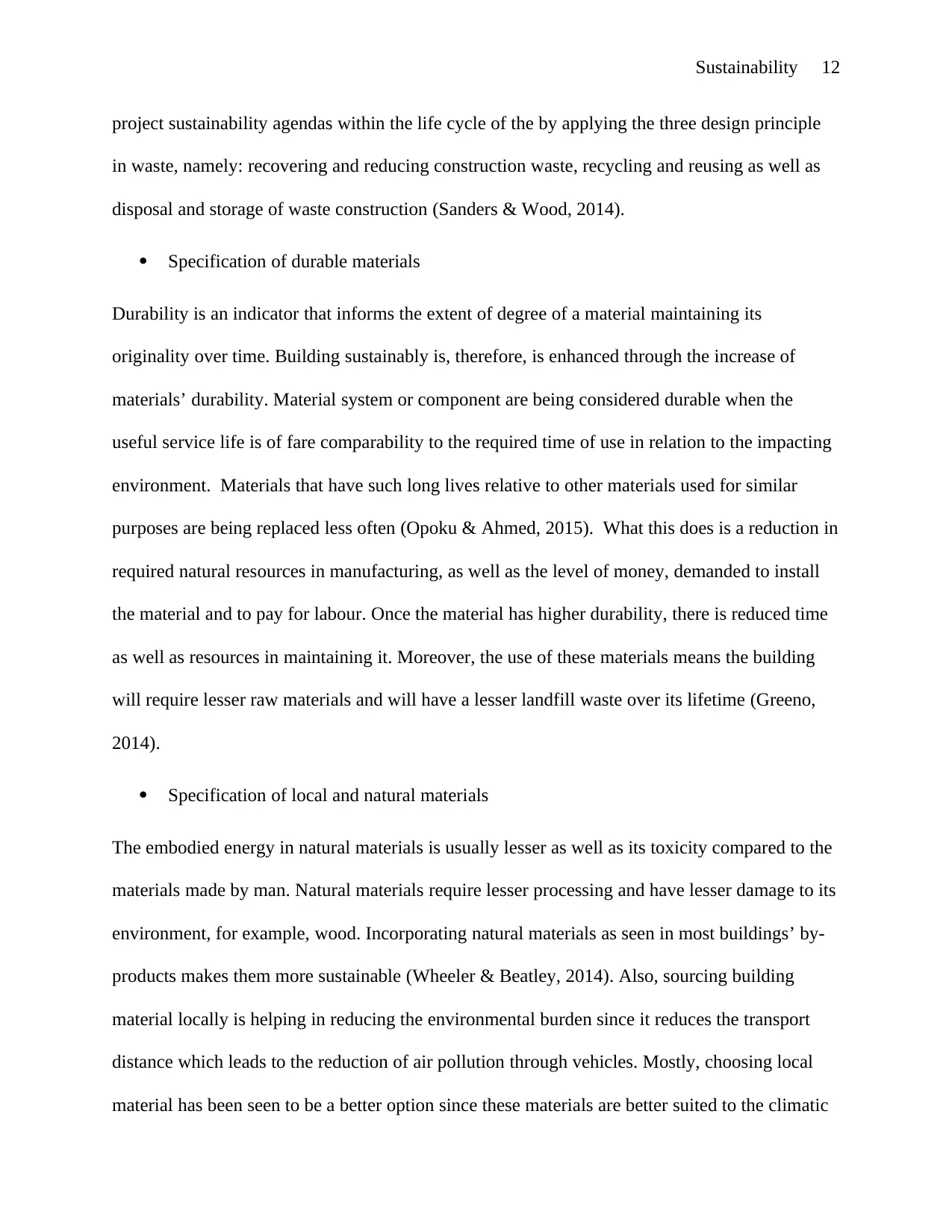
Sustainability 12
project sustainability agendas within the life cycle of the by applying the three design principle
in waste, namely: recovering and reducing construction waste, recycling and reusing as well as
disposal and storage of waste construction (Sanders & Wood, 2014).
Specification of durable materials
Durability is an indicator that informs the extent of degree of a material maintaining its
originality over time. Building sustainably is, therefore, is enhanced through the increase of
materials’ durability. Material system or component are being considered durable when the
useful service life is of fare comparability to the required time of use in relation to the impacting
environment. Materials that have such long lives relative to other materials used for similar
purposes are being replaced less often (Opoku & Ahmed, 2015). What this does is a reduction in
required natural resources in manufacturing, as well as the level of money, demanded to install
the material and to pay for labour. Once the material has higher durability, there is reduced time
as well as resources in maintaining it. Moreover, the use of these materials means the building
will require lesser raw materials and will have a lesser landfill waste over its lifetime (Greeno,
2014).
Specification of local and natural materials
The embodied energy in natural materials is usually lesser as well as its toxicity compared to the
materials made by man. Natural materials require lesser processing and have lesser damage to its
environment, for example, wood. Incorporating natural materials as seen in most buildings’ by-
products makes them more sustainable (Wheeler & Beatley, 2014). Also, sourcing building
material locally is helping in reducing the environmental burden since it reduces the transport
distance which leads to the reduction of air pollution through vehicles. Mostly, choosing local
material has been seen to be a better option since these materials are better suited to the climatic
project sustainability agendas within the life cycle of the by applying the three design principle
in waste, namely: recovering and reducing construction waste, recycling and reusing as well as
disposal and storage of waste construction (Sanders & Wood, 2014).
Specification of durable materials
Durability is an indicator that informs the extent of degree of a material maintaining its
originality over time. Building sustainably is, therefore, is enhanced through the increase of
materials’ durability. Material system or component are being considered durable when the
useful service life is of fare comparability to the required time of use in relation to the impacting
environment. Materials that have such long lives relative to other materials used for similar
purposes are being replaced less often (Opoku & Ahmed, 2015). What this does is a reduction in
required natural resources in manufacturing, as well as the level of money, demanded to install
the material and to pay for labour. Once the material has higher durability, there is reduced time
as well as resources in maintaining it. Moreover, the use of these materials means the building
will require lesser raw materials and will have a lesser landfill waste over its lifetime (Greeno,
2014).
Specification of local and natural materials
The embodied energy in natural materials is usually lesser as well as its toxicity compared to the
materials made by man. Natural materials require lesser processing and have lesser damage to its
environment, for example, wood. Incorporating natural materials as seen in most buildings’ by-
products makes them more sustainable (Wheeler & Beatley, 2014). Also, sourcing building
material locally is helping in reducing the environmental burden since it reduces the transport
distance which leads to the reduction of air pollution through vehicles. Mostly, choosing local
material has been seen to be a better option since these materials are better suited to the climatic
⊘ This is a preview!⊘
Do you want full access?
Subscribe today to unlock all pages.

Trusted by 1+ million students worldwide
1 out of 32
Related Documents
Your All-in-One AI-Powered Toolkit for Academic Success.
+13062052269
info@desklib.com
Available 24*7 on WhatsApp / Email
![[object Object]](/_next/static/media/star-bottom.7253800d.svg)
Unlock your academic potential
Copyright © 2020–2025 A2Z Services. All Rights Reserved. Developed and managed by ZUCOL.





